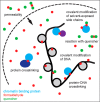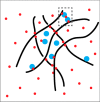Formaldehyde crosslinking: a tool for the study of chromatin complexes
- PMID: 26354429
- PMCID: PMC4646298
- DOI: 10.1074/jbc.R115.651679
Formaldehyde crosslinking: a tool for the study of chromatin complexes
Abstract
Formaldehyde has been used for decades to probe macromolecular structure and function and to trap complexes, cells, and tissues for further analysis. Formaldehyde crosslinking is routinely employed for detection and quantification of protein-DNA interactions, interactions between chromatin proteins, and interactions between distal segments of the chromatin fiber. Despite widespread use and a rich biochemical literature, important aspects of formaldehyde behavior in cells have not been well described. Here, we highlight features of formaldehyde chemistry relevant to its use in analyses of chromatin complexes, focusing on how its properties may influence studies of chromatin structure and function.
Keywords: chromatin immunoprecipitation (ChIP); chromatin structure; formaldehyde chemistry; nucleic acid chemistry; protein cross-linking; transcription factor.
© 2015 by The American Society for Biochemistry and Molecular Biology, Inc.
Figures




Similar articles
-
Second-generation method for analysis of chromatin binding with formaldehyde-cross-linking kinetics.J Biol Chem. 2017 Nov 24;292(47):19338-19355. doi: 10.1074/jbc.M117.796441. Epub 2017 Sep 26. J Biol Chem. 2017. PMID: 28972159 Free PMC article.
-
ChIP bias as a function of cross-linking time.Chromosome Res. 2016 May;24(2):175-81. doi: 10.1007/s10577-015-9509-1. Epub 2015 Dec 21. Chromosome Res. 2016. PMID: 26685864 Free PMC article.
-
Crosslinking intensity modulates the reliability and sensitivity of chromatin conformation detection at different structural levels.Commun Biol. 2024 Sep 30;7(1):1216. doi: 10.1038/s42003-024-06904-0. Commun Biol. 2024. PMID: 39349577 Free PMC article.
-
Mapping chromosomal proteins in vivo by formaldehyde-crosslinked-chromatin immunoprecipitation.Trends Biochem Sci. 2000 Mar;25(3):99-104. doi: 10.1016/s0968-0004(99)01535-2. Trends Biochem Sci. 2000. PMID: 10694875 Review.
-
Formaldehyde-assisted isolation of regulatory elements.Wiley Interdiscip Rev Syst Biol Med. 2009 Nov-Dec;1(3):400-406. doi: 10.1002/wsbm.36. Wiley Interdiscip Rev Syst Biol Med. 2009. PMID: 20046543 Free PMC article. Review.
Cited by
-
Coherent anti-Stokes Raman scattering cell imaging and segmentation with unsupervised data analysis.Front Cell Dev Biol. 2022 Aug 16;10:933897. doi: 10.3389/fcell.2022.933897. eCollection 2022. Front Cell Dev Biol. 2022. PMID: 36051442 Free PMC article.
-
Towards an Ideal In Cell Hybridization-Based Strategy to Discover Protein Interactomes of Selected RNA Molecules.Int J Mol Sci. 2022 Jan 15;23(2):942. doi: 10.3390/ijms23020942. Int J Mol Sci. 2022. PMID: 35055128 Free PMC article. Review.
-
EMbedding and Backscattered Scanning Electron Microscopy: A Detailed Protocol for the Whole-Specimen, High-Resolution Analysis of Cardiovascular Tissues.Front Cardiovasc Med. 2021 Oct 25;8:739549. doi: 10.3389/fcvm.2021.739549. eCollection 2021. Front Cardiovasc Med. 2021. PMID: 34760942 Free PMC article.
-
High-resolution map of plastid-encoded RNA polymerase binding patterns demonstrates a major role of transcription in chloroplast gene expression.Plant J. 2022 Aug;111(4):1139-1151. doi: 10.1111/tpj.15882. Epub 2022 Jul 13. Plant J. 2022. PMID: 35765883 Free PMC article.
-
Understanding the chemistry of the artificial electron acceptors PES, PMS, DCPIP and Wurster's Blue in methanol dehydrogenase assays.J Biol Inorg Chem. 2020 Mar;25(2):199-212. doi: 10.1007/s00775-020-01752-9. Epub 2020 Feb 14. J Biol Inorg Chem. 2020. PMID: 32060650 Free PMC article.
References
-
- Eckels K. H., and Putnak R. (2003) Formalin-inactivated whole virus and recombinant subunit flavivirus vaccines. Adv. Virus Res. 61, 395–418 - PubMed
-
- Werner M., Chott A., Fabiano A., and Battifora H. (2000) Effect of formalin tissue fixation and processing on immunohistochemistry. Am. J. Surg. Pathol. 24, 1016–1019 - PubMed
-
- Fraenkel-Conrat H., Cooper M., and Olcott H. S. (1945) The reaction of formaldehyde with proteins. J. Am. Chem. Soc. 67, 950–954
Publication types
MeSH terms
Substances
Grants and funding
LinkOut - more resources
Full Text Sources
Other Literature Sources

